|
Welcome to my Blog dedicated to my astronomy observations. You will find summaries of what I did during the night, my issues, and the pictures that I took.
You can click on the pictures to see a bigger size, and to have more information about the conditions, the equipment used and the technical details. Don't hesitate to contact me at guillaume_lafarge@yahoo.fr for any question or things about this site. |
- July 23 2012, Carnac, Morbihan (dept. 56, France)
The sky is perfect, I go outside the town, behind the "Men Du". I decide to target M51 with Canon 450D with a 250mm zoom. The 30s exposures seem quite good.
I found interesting shooting a galaxy with only common zoom and reflex camera.

- July 22 2012, Carnac, Morbihan (dept. 56, France)
I try for the first time the EQ1 mount I bought last year to "l'Astronome" in Lorient. It is a small motorized mount for traveling. After having it installed on a garden table, I put a small refractor on it Orion Short Tube (F=400mm). The first problem is the initial setting, particulary pointing the polar star without finder scope. Then I discover the problem of axing the scope. Trying to target Cygnus at the top of the sky, the mount is limitated in rotation because of the engine which touches the equipment. This night allowed to train with this new mount, but I could not do a good picture.
- July 20 2012, Thézac, Charente Maritime (dept. 17, France)
No moon, ideal conditions. I redo the configuration with the C8 telescope and 80ED refractor for guiding in parallel of the EQ6 mount, but I add the focal reducer on the C8.
I shoot with the Atik 314L CCD camera at F=1260mm, and for the 80ED refractor , I guide with the Lodestar at F=1200mm.
The guiding is not very good, I do 3 minutes exposures.
I first target the planetary nebula NGC 6905, named the "Blue flash", the Doplhin constellation.
I found this target thanks to Chritian Dupriez (refer to my page useful links), who is a very good amateur.
But I can realize very quickly that my guiding is not good, probably because of a bad too fast polar alignment.
Then I also find on his site the NGC 266 galaxy, a spiral barred one in the Andromeda constellation. I wanted to do a galaxy,
because I understood that the summer sky shows more nebulae than galaxies. I think it is because of the Milky Way
is on top of the sky, so good targets are there (Cygnus, Cassiopea, Lyra...), and fue galaxies are visible
through these many stars
Going to bed at 4:50.


- July 16 2012, Thézac, Charente Maritime (dept. 17, France)
Exceptional night. No moon, ideal conditions. I install the C8 telescope and the 80ED refractor in parralel on the EQ6 mount.
Regarding the C8 I shoo t with the Atik 314L+ at the focal point, and for the 80ED refractor, I put a x2 barlow lens, and install the LodeStar for guiding.
I makes a 2000mm focal length for imaging, and 1200mm for guiding. The guiding is quite good, so I do 5 minutes exposures.
I do first NGC 7048, a planetary nebula in Cygnus, then M76 which I failed before.
Going to bed at 4:20.


- July 15 2012, Thézac, Charente Maritime (dept. 17, France)
First night of the year, at last. Very good night. No moon, ideal conditions. I scheduled my holidays in this period of july where the moon is weak, I did well. I mount the C8 telescope and the 80ED refractor in parralel on the EQ6 mount.
Regarding the C8, I shoot with the Canon 450D reflex camera with a focal reducer 1.6, and regarding the 80ED refractor, I add a x2 barlow lens, and use the LodeStar camera for guiding.
I makes a 1250mm focal length for imaging, and 1200mm for guiding, which is perfect. Guiding works fine, I do 2 minutes exposures.
I first target M33 the Triangle galaxy, then M27 the Dumbbell nebula, usual targets for training.
Going to bed at 4am.


2011 : 11 nights
- October 1st 2011 le Chesnoy (dept. 45, France)
The might is perfect, no moon. I try at le Chesnoy for the first time, there is no artificial light 100km away from Paris.
I install the CG5 mount with the 80ED refractor at F=600mm, the the Atik 314L+ camera. I do IC1396 the elephant's trunk, the galaxy M74, the bubble nebula, the nebula NGC7380, and Cygnus nebula. I wanted to do the maximum as the weather was great. And at 4am.




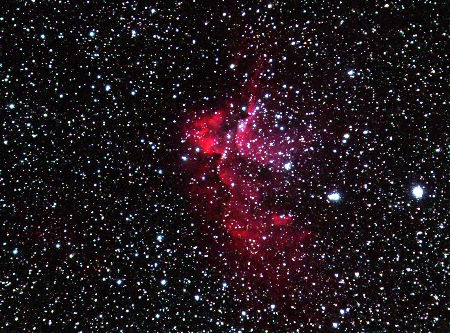
- August 19 2011 Thézac, Charente Maritime (dept. 17, France)
The night is good, but the moon is shiny. I struggle with the filter wheel to mak it work, and I finally succeed. I enjoy maximum of this night of astronomy, because they are rare this year. Equipment: EQ6 mount, C8 telescope F=2000mm puis 4000mm) + Orion Short Tube refractor, Atik 314L+ camera then DMK31 camera. I do NGC7331, NGC6826, M57, M27, NGC6946, IC5146 (cocoon nebula), Jupiter and the moon. I finally arrive to guide correctly, because I discovered that PHDGuiding did not guide in declinason, I needed to activate this feature. Then it was guiding on the 2 axis, it's better! I'm very happy of the result on Jupiter, but curiously I could not merge the LRGB colors layers. I finally arrive to have details on the clouds of the planet. For the moon I am also happy of the result. For the other objects, I am quite disapointed, except may be for M57, but the colors are quite strange. Going to bed at 5am. It was the last night of the summer, I didn't have totally black nights, but I could improve my skills in planetary imaging and guiding.



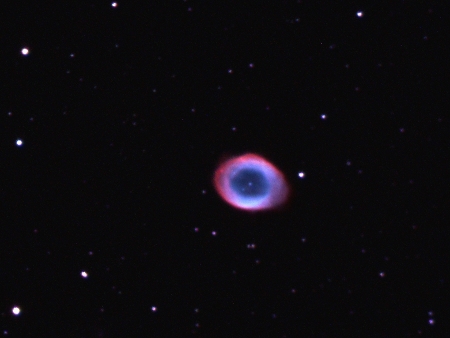
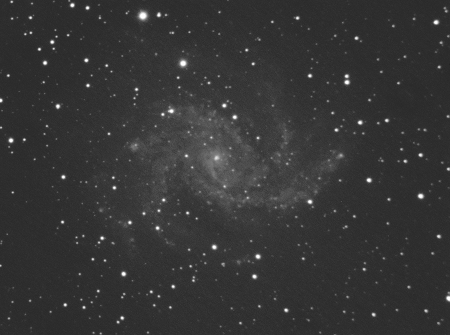





- August 15 2011 Thézac, Charente Maritime (dept. 17, France)
Beautiful and hot night, but disturbing moon. I mount the C8 telescope on the EQ6 mount, with the Orion Short Tube refractor for guiding, with a x2 barlow lens and the Startlight Xpress LodeStar camera. On the C8, after having plugged the Atik 314L+ and the Atik filter wheel, I realize that the filter wheel still doesn't work, it is blocked. I just remove the wheel each time to change the filter manually. It is very tedious, and the problem is the field rotation. I do M76 which I failed lst time, then Jupiter, then the Pleiades with wide field Canon. In bed at 6am! For the processing of the images, I struggle with M76 because I don't know how to register images with the field rotation. The result is bad. For Jupiter, it is not very good, but I could do LRGB. For Pleiades, I am not happy wiith the result, because I thought that the guiding was better, the moon was disturbing a lot, and the exposure time was not enough.



- August 10 août 2011 Thézac, Charente Maritime (dept. 17, France)
Beautiful night, but disturbing moon, calm, a little bit humid. I install the C8 telescope on the EQ6 mount. I also install my new Orion Short tube refractor, lighter than the 80ED refractor, for guiding, with a x3 barlow lens and the Starlight Xpress LodeStar CCD camera. It is not the weight itself which was disturbing, because the EQ6 can easily carry the C8 + the 80ED, it was more the bending problem. On the C8, after installing the Atik 314L+ camera and the Atik filter wheel, I realized that the filter wheel was not working, it was blocked (fortunately I repared it the following day by simply disassembling it). So I finally install the Canon 450D (it is a chance to have several possibilities). As I hadn't prepared what I wanted to target, I start by the NGC 7331 galaxy, which I consider pretty. I already did it last year with the Atik, but not very well done. I do 45s exposures. Then I shoot M31. Then I install the Atik 314L+, without any filter, and I target M27, easy to shoot. Then I test Uranus, for a try. I can see the disk, the the Atik is not adapted for that, I'll redo it some other time. At last, as Jupiter is quite high in the sky at the end of the night, I try the DMK31 camera to see what it can do. However I didn't take the time to do the collimation, and I do the focusing with an empirical way, by watching on the PC. I take an avi movie of 500 images. The result is better than what I could do with the old webcam, which was not satisfying for me. End at around 4:10am, the moon at last disapeared at around 4am, but it's too late, I don't have the courage to continue. However the sky becomes extraordinary, no noise, no wind, zero artificial light, no cloud, no moon. I can see the Andromeda galaxy directly with my naked eyes, the Milky way, Jupiter near the Pleiades...la galaxie d'Andromède à l'oeil nu, la Voie Lactée, Jupiter à côté des Pléiades...



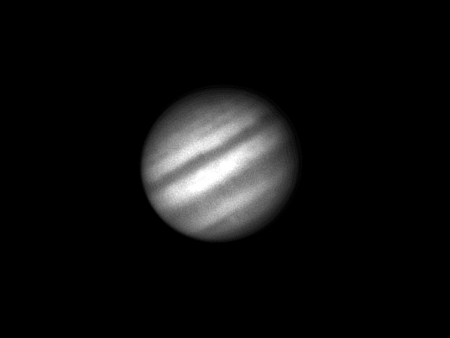
- June 3 2011 Sommières-du-Clain, Vienne (dept. 86, France)
Beautiful night, no moon, calm. Still with the Orion 80ED refractor, but this time with the Atik 314L+, I target some Messier objects in the Big Dipper: M109, then M51 and M63. I do RGB exposures in binning 2x2, and L in 1x1. Processing the images was difficult. Next time, I'll do all in binning 1x1. I am improving my skills, but it is not yet good for me.



- June 1 2011 Sommières-du-Clain, Vienne (dept. 86, France)
The night was beautiful, without moon, but very windy and therefore quite cold. After failing to use the Orion off-axis guider, because I could not focus and settle the LodeStar, I shoot M51 by around 45 exposures of 60s, a long time that I have never done. I use the 80ED Orion with the Canon 450D at 1600ISO. I am quite happy with the result compared to my previous tries. Then before leaving, I do quickly M27 in 4 exposures of 60s. These are my two grand classicals, but it is good for training. Moreover I realized that M51 is less well located in the sky in summer whereas in spring it is at the top of the sky. Information given after: a new supernova appeared in M51 that night (cf astrosurf forum), you can see it on my picture! It is the big white point near the arm that start from the big galaxy to the small one.


- May 23 2011 Suresnes, Hauts-de-Seine (dept. 92, France)
After having browsed Thierry Legault's site, famous amateur, a reference in this domain, I wanted to apply his collimation method, explained in details. Indeed I have never collimated the C8 telescope, and he says it is important for planetary imaging. I take advantage of this work to clean the telescope's lens which holds the secondary mirror.
I try Syrius, not far from Saturn. Step by step, I can get concentric circles...
Then I try the DMK 31 camera on Saturn, with a x2 barlow lns. I also try an anti-infrared filter. With the ocular, the sight is great, I can see the darker bands on the shere, and the rings well contrasted, and their shodow visible on the shere.

- April 8 2011 Suresnes, Hauts-de-Seine (dept. 92, France)
I wanted to try the Orion off-axis guider, I target M51. Impossible to focus the LodeStar camera, I'll fix later this problem. I try M51 with the Atik 314L+ at F=2000m. The result is not very good, and RGB shots are bad.

- April 7 2011 Suresnes, Hauts-de-Seine (dept. 92, France)
I try the DMK31 on Saturn, which is almost as close as possible to the Earth. I have a lot to learn!

- Februrary 19 2011 Thézac, Charente Maritime (dept. 17, France)
I try again the Orion nebula, doing more exposures, with 1600 ISO sensibility. I still use the 80ED refractor on the EQ6 mount, without guiding, and the Canon 450D reflex camera. The moon is not yet risen at 8pm, but the foor lamps are embarrassing. This time a take all in raw mode, which I forgot to do on the 17th.

- Februrary 17 2011 Thézac, Charente Maritime (dept. 17, France)
First night of the year, I will at last be able to target the Orion constellation. Conditions are not ideal, with a full moon and a lot of dew. I decide to shoot the Orion nebula M42, and the Horse head nebula, in the same constellation. I take M42 with the Canon 450D reflex camera, in not more than 800 ISO because of the moon light, and 30s exposures because I don't guide. For the Horse head, I use the Atik 314L+ in order to shoot with a H-alpha filter. I test for the first time my flat field screen bought to "l'Astronome".
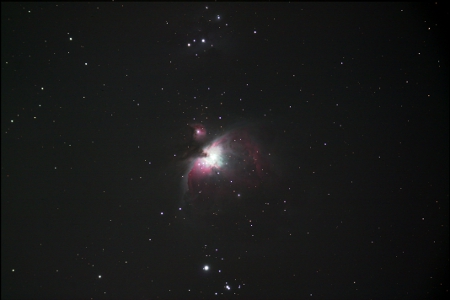


2010 : 16 nights
- September 20 2010 Suresnes, Hauts-de-Seine (dept. 92, France)
Jupiter is as close as possible to the Earth and the weather is good. So I have to use my telescope! In addition I want to try the CG5 mount which MEDAS repared and returned. I test with the Pentaflex webcam, then with the Atik, which is not designed for planetary imaging, but it is for fun...
I pack all at around midnight, the battery is empty, and I work the following day. I try to take mpg videos to train with Registax software. The result is not very good, but anyway the raw pictures are also not good. In the end I'm really not good for planetary images, when I see what others do on astrosurf forum...
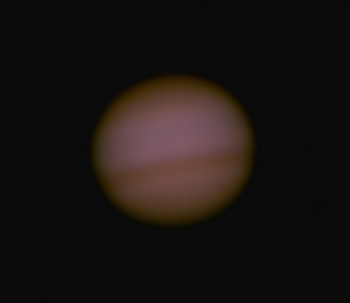

- August 28-29 2010 Thézac, Charente Maritime (dept. 17, France)
This is the last day of my vacations, and the weather is nice. The night is quite cold (10°C), and it becomes quite humid which makes dew on the refractor, because I still don't have dew heater. I search targets near Cygnus, high in the sky. I try the NGC6826 nebula with C8 telescope, hard to find with long focal length, then Cygnus nebula with the refractor, I redo the Cocoon nebula which I had failed before. Then I redo the Pacman nebula, this time with the refractor with H-alpha filter. Then I try the moon and Jupiter with the Atik camera, for testing. I end with the NGC6946 galaxy. What an exhausting night before driving the next day! Sleep at 4:15am


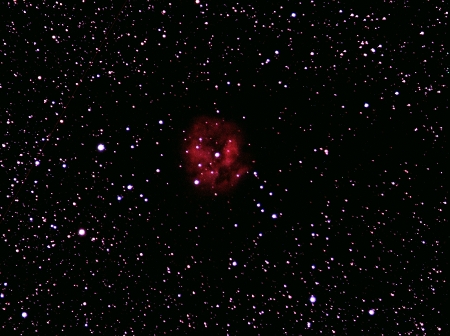



- August 25-26 2010 Thézac, Charente Maritime (dept. 17, France)
The moon is still full, I decide to try another configuration: shooting with Orion 80ED refractor, with the Atik 314L+, guiding with the C8 telescope and the LodeStar camera. I've seen the Cocoon nebula on the internet, which is well located currentlty, and that I have never done before. I first make a test on M27 which I know well. I found out that my problems with guiding of previous days were due to the fact I had not activated the guiding on declination axis! Guiding works much better now. So I do 5 minutes exposures without any problem. But a new issue comes: dew is appearing on the refractor, because I don't have dew heater. I use the one of the C8, which works for a while only after having removed it. At last, the battery runs out of order. I don't have time to make good shots in blue and green of the Cocoon nebula, and thoses I took are bad because of the dew.

- August 24-25 août 2010 Thézac, Charente Maritime (dept. 17;, France)
The sky is clear, but a few clouds, and plane clouds. The moon is full, and the air is very humid. The conditions are not very good, so I try the off-axis guider with the extension tube which I made myself, and the Lodestar. But I still need to ajust my setting, for later, because the focal plan is not at the right place. So I try to shoot the moon and Jupiter, the only easy targets.



- August 21-22 2010 Thézac, Charente Maritime (dept. 17, France)
The weather is hot and clear, but the moon is very annoying. I try M51 which is quite low in the sky. After processing, the result is not good, I think I'll redo this galaxy rather in spring, it is not an object to do in summer. The polar alignment is good, and the Goto pointing works very fine. Then I do the Pacman nebula, NGC281, with H-alpha exposures which reveal it well. Configuration: C8 telescope at F=1260mm, guiding with 80ED Orion refractor, camera LodeStar Starlight Xpress. Then I try Uranus and the Cygnus nebula, but with no result, clouds are coming, a strom is arriving. End at 2:15am


- August 20-21 2010 Thézac, Charente Maritime (dept. 17, France)
Quite good conditions, but high humidity with low temporary fog, and the moon is visible.I test the NGC7331 galaxy which I had seen on the internet, then M27 and M57 quite high in the sky. The humidity is very important and dew is appearing on the 80ED Orion refractor. I shoot with the Artemis software provided with the Atik 314L+ on the C8 telescope with a focal reducer (6.3), and I guide with the 80ED Orion refractor, camera LodeStar Starlight Xpress, software PHDGuiding. I do the galaxy NGC 7331 which I have seen on the internet, and I found it fine, then I do M57, the M27. End at 4:15am.



- August 19-20 2010 Thézac, Charente Maritime (dept. 17, France)
I finally received the NEQ6 SkyWatcher Goto mount. Even if the weather is rather cloudy, some clear sky holes allow me to do the polar alignment, and to train with the mount. It is very heavy, but also very stable. It carries mush better the load of the C8 telescope and the Orion 80ED refractor. It is mush less noisy than the Celestron CG5. It is also more precise with the hand controller. In the end it is a good purchase. I set the polar reticle, then I make the alignment of the Goto function on 3 stars. The usage of the hand controller is quite similar to that of CG5 mount. I consider that the CG5 mount is is of poor quality compare to this one.
- August 16-17 2010 Thézac, Charente Maritime (dept. 17, France)
I don't have the CG5 mount which is at Medas for repair, I haven't received the EQ6 yet. So I first get out the old dad's Newton telescope D=113,F=900, to do only visual observation. I target easily Jupiter and the Andromeda galaxy, but when I want to see the ring nebula M57, or the dumbbell nebula M27, I can't find them. I try then the milky way and the Thézac church with the camera on tripod. Processing the images is difficult. Regarding the milky way, stars don't have the same shape on all the plan, for the church, adding the images is not compatible with aligning both stars and the church. So I do twice the processing, once with aligning the stars, another time the church, then I merge teh two results by lightenning the church. Jupiter is visible in the sky. The result is funny:
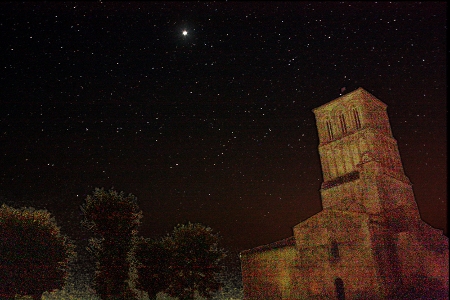
- August 12-13 2010 Thézac, Charente Maritime (dept. 17, France)
The forecast annonces clouds, but I try my chance. I first want to try guiding with the off-axis guider and the LodeStar. I find out 2 problems: 1) impossible to settle the LodeStar in the focal plan, because the guiding axis touches the camera...
Finally, I decide to shoot with the C8 and the Atik, guiding with the 80ED refractor. Problem: when I add the refractor and the counterweight, ot makes the axis of the mount move, now unsettled. Well, I redo the alignmet with two stars. But I find the mount is making a strange noise, and it seem forcing. I am able to do M57, but clouds are here, I stop the mess. While packing, I realize that the mount has really a problem, the declinason axis is blocked. The following day, I call MEDAS, who tell me it is a well known problem on the CG5 mount, the internal friction of the aluminium create filing, which finish to block the mount. They tell me to send them the mount for repair, I do it immediatly (guarantee is ok). This CG5 is not great, so I buy an EQ6 GoTo on a whim on the internet, with sale, without shipping cost. As my vacations is not eternal, I don't wait, and I had already more or less the idea to have a strong mount which would stay at this place, where conditions are the best. This time, guiding will be good I hope. I'll use the CG5 elsewhere, and I will not load it so much anymore with the refractor for guiding.

- August 9-10 2010 Thézac, Charente Maritime (dept. 17, France)
I start the polar alignment around 11pm, the forecast is good on the internet for this night. I change configuration, guiding with C8 telescope at its focal length, and shooting with Orion 80ED refractor, and wide field pictures with the reflex camera.
Guiding works very well, because the focal length of the C8 (2000mm) is much longer than that of refractor (600mm).
I start by the set of galaxies M81 and M82, with 1mn exposures, then 3mn, then 4mn.
Then I do M31 (Andromeda) by one single exposure of 9mn45s. Indeed I already shot M31 with long exposure time with zoom only, and the result isbetter than adding shorter exposures. When we make images addition, it burns the kernel of the galaxy.
Then I do two 5mn exposures of M101, which I found difficult to do in 2009. It is however quite low in the sky, but it works.
I continue whith two 5mn exposures of M33, the Triangle galaxy, which I have never done before. It is well located in the sky, quite high at the East.
I finish with a 1mn exposure, then a 5mn exposure on M45, the Pleiades. I pack all at 3:30am, good harvest!
- August 8-9 2010 Thézac, Charente Maritime (dept. 17, France)
I start polar alignment around 9pm, because ther is no cloud. My goal is to test the biggest configuration: C8 + guiding with Oron refractor, using LodeStar for guiding, shooting with Atik 314L+
I take time to do a good setting: adjust mount horizontal, polar alignment, refractor parallel with the telescope, and focusing. For parallelism, I use aa reticle ocular to center the same star in both scopes. For fucsing, I use Artemis software of Atik, which allows to zoom on a star.
I start with the Bubble nebula, which I had difficulty to do with reflex camera only. I do 5 exposures of 3mn on each filter L, R, G, and B, then 6 exposures of 3mn H-alpha. Je realize that the H-alpha filter is very efficient.
For guiding, I find out that PHDGuiding software sometimes loses control, and it does visual and sound alerts. Then we need to click again on the guiding star and to start again guiding. It is a useful software.
I do 3 darks of 3mn, and 30 offsets
Then I target NGC891 galaxy, which I wanted to do since a long time, and which is not far from the Bubble nebula. I do 2 3mn exposures per filter. I try H-alpha, but it doesn't work very good, which seems normal to me.
I try then M45 (the Pleiades) which have risen quite high in the sky on the Est side, but it zooms too much, the focal length is too long. Then I try M31 which is also in the same location in the sky, same problem.
Therefore I try M27, which I quite well did in 2009 with the reflex camera.
I pack all around 4:40am, the night was long!
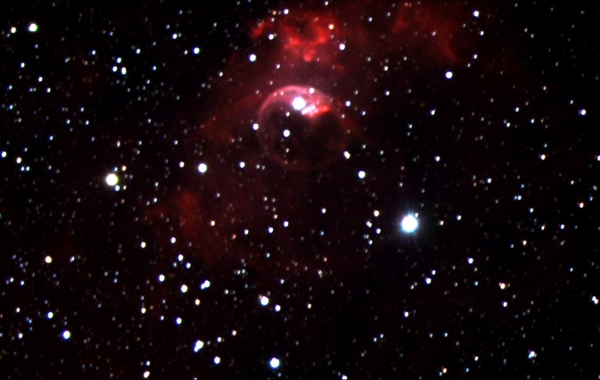

- May 23-24 2010 Suresnes, Hauts-de-Seine (dept. 92, France)
As the weather is good and I don't work tomorrow, I install again all the equipment. I need to train for this summer. I target M109, still in the Big Dipper, quite high in the sky. Its magnitude is low (9.8) compare to M51 (8.4), and I would like to see if it can make a good result in Paris suburbs.
I try the functions of Artemis which allow to do a better focusing, its is fine and easy.
I start: 10x120s binning 1x1 with L filter, 5x60s binning 2x2 filters R,G and B, 4 darks and 30 offsets for filters L, 3 darks and 20 offsets for RGB, and I test one exposure of 5mn with L filter for a try. I immedialty realize that the background of the sky is too noisy, in addition the moon is shiny tonight. Sleep at 2:15am. About processing, I understand that doing a binning different for RGB was not a good idea, because adding with the L layer is difficult, I must reduce the resolution. The result is bad, and I think now that I will not be able to try too low magnitudes here. M51 can be ok, I need to list the possibilities.
However I like this galaxy, I will do it at Thézac for sure.

- May 22-23 2010 Suresnes, Hauts-de-Seine (dept. 92, France)
I have received the Atik 314L+ CCD camera this morning, I will be able to test it tonight. I don't guide with the refractor in order not to cumulate the problems for the first try. I choose M51 again which is easy to shoot, because bright enough. I install: the C8 telescope with 6.3 focal reducer, the T ring with the filter wheel Atik USB, then the CCD. I discover the Artemis software that is really good, easy to use. I understand that it was a good choice to purchase a motorized filter wheel, because the software allow me to program everything. I first focus with small exposures, then I adjust the exposure time to 30s, because the guiding is not very good. I am very happy with the first tests, because I did not think succeed in a so light polluted place. I take 20 exposures of 30s in luminance, 10 in red, 10 in green, 10 in blue. Then 3 darks of 30s, and 20 offsets of 0.001s. The next day I try to process all these images with IRIS software, and here is the result, not great yet, but it is a start. I realize that the binning makes lower quality, and that I need more exposures. The field is much smaller than the reflex camera, because the sensor chip is smaller, so framining was more difficult. Fortunately, the computer is useful for this.

- May 17-18 2010 Suresnes, Hauts-de-Seine (dept. 92, France)
There is no clouds tonight, it's been a long time since there was no clouds. I decide to get out the telescope to test guiding the C8 with the Orion 80ED refractor in parallel, and train for this summer. It allows me to discover the problem of balancing which becomes difficult with the refractor and the additional counterweight. I asked Celestron, who told me the mount can carry 30 pounds, 13.6kg. I mesured every weight (see equipment page) it should work. I rake ths opportunity to try my new head light with no battery, it is really useful.
I decide to do the mount alignment without the refractor installed. My second alignment star for the GoTo is Arcturus, well visible, and I decide to stay on this one for my tests.
I point the star with the reticle ocular on the C8, then I do the same on the refractor so that it is well parallel. I repeat 2 or 3 times the process to fix the small faults.
Then I plug the LodeStar CCD on the refractor, and I do focusing with PHDGuiding, the guiding software. I install the Canon at the focal point of the C8, and do the focus with my eyes, then with the screen which allows to zoom.
I take 2 pictures of 1mn and 1mn30s to see the guiding issues before activating guiding.
PHDGuiding setup makes me problems, because I don't knoww what mount I shoud use. Finally, I understand that I need on-camera one, because the cable for guiding is plugged from the LodeStar to the mount directly. Then I launch guiding, it works! I redo the same exposure time: perfect, stars are points!!
Happy, I pack all around 1:30am, because tomorrow, work...emballe tout vers 1h30, car demain, boulot...
Arcturus, without guiding 90s Arcturus, with guiding 90s 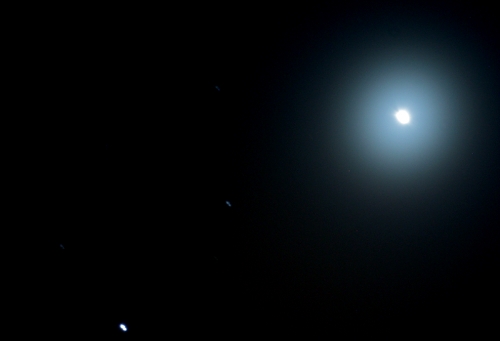

- April 24-25 2010 Thézac, Charente Maritime (dept. 17, France)
The sky was covered with coulds during the day, but at 11pm I watch the night forecast of Charente Maritime (Météo France), they annonce a clear night. Indeed the sky is clearing. I get out all the equipment which I avec just packed because we are leaving tomorrow...
The night is very lighted by the moon, which is annoying. I target M81 quite high, and at the opposite side of the moon. I take 43 exposures of 30s, because 60s takes too much the light of the moon. I also take darks of 30s, and one of 60s which will be useful later.
The I target M101, and I do 27 exposures of 60s for a try (not good). I pack all at 1:45am, because I'll drive tomorrow.
Summary of the vacation: one good M51, M101 and M81 to process, no guiding test for the moment.

- April 18-19 2010 Thézac, Charente Maritime (dept. 17, France)
First vacation day, the sky is totally clear => I prepare the telescope, and do 1 flat field of 60s and 1 of 30s, even if I am not yet comfortable with makeing flats... I know that I will be able to test processes with IRIS software. First night of the year.
The night is perfect, no moon, no clouds, no artificial light.
I target M51 which is well located in the sky at the top in this period (=>less atmosphere to cross), and easy to shoot.
I already didi it before, but I am not satisfied with the result.
I want to test my new StarLight Xpress LodeStar camera received this month (l'Astronome shop), and do guiding with the off-axis guider.
I discover one problem: I cannot focus both the LodeStar and the reflex camera.
I dn't know yet if it is because I can't find a guiding star, but the man from the "l'Astronome" shop confirms this issue.
I need either an exension tube for the guider, or a ring for the reflex camera.
So I give up, and I shoot M51 with the reflex camera at the focal plan, avec a 6.3 reducer.
New problem: I realize that the guiding is very bad! In fact I totally missed the polar alignment: wrong star! I pointed it when it was still the day, too quickly, => error.
I now understand why the alignment was so difficult. The GoTo function still could however point was I was asking!!
So I redo ctotally the polar alignment, then I take 30s and 60s exposures. As guiding was very good, I stay at 60s.

2009 : 19 nights
- August 22-23 2009 Thézac, Charente Maritime (dept. 17, France)
Last night of the vacation. I try again the Bubble nebula, which I want to succeed. I want to try manual guiding with the off-axis guider, but impossible to find a guiding star. It is a well known problem on the internet. These vacations were particulary good for night observation, with lots of nights.
- August 21-22 2009 Thézac, Charente Maritime (dept. 17, France)
I shoot the Sunflower galaxy M76, then M31 with manual guiding with the C8 telescope, imaging with the reflex camera at F=250mm F5.6 1600ISO 600 seconds! Great result for one single shot. The I tak M45 which is raising at the East at the end of the night (same configuration).
- August 19-20 2009 Thézac, Charente Maritime (dept. 17, France)
M27 390s with reflex camera at 1600ISO, guiding with off-axis guider works fine here, because M27 is in the Milky way full of stars, the guiding star is easy to find. It is exhausting for my eye, but the result is great. I also shoot M31.
- Agust 18-19 2009 Thézac, Charente Maritime (dept. 17, France)
I want to try many objects this night. I target M56, NGC7835 (Nébuleuse de la Bulle), NGC6946, NGC7009, NGC7635. IC5070: I don't know what it is but it doesn't show anything interesting. I also try Neptun: nothing visible. Then I do M31 guiding with the C8, and the reflex camera in parallel on the scope, with 250mm zoom. I take one 600s exposure: great result. Guiding works fine because the focal length 2000mm is much longer than 250mm of the camera. I also take the Milky way, then M45 at the end of the night which raise at the East side.
- August 17 2009 Thézac, Charente Maritime (dept. 17, France)
I try the webcam on the moon: not good. I prefer the reflex camera which has a better sensor chip for this usage.
- August 16 2009 Thézac, Charente Maritime (dept. 17, France)
M31, NGC7635
- August 14-15 2009 Thézac, Charente Maritime (dept. 17, France)
M27: I can see it well with my naked eye in the telescope. In image, the result is fine, and it is colored! I do also M31, M57 and NGC7662. I also try the Mylky way with the reflex camera in parallel of the C8, with a 18-55mm zoom, manual guiding with the C8. The difficulty is focusing. I take 63s exposures at 1600ISO.
- August 13-14 2009 Thézac, Charente Maritime (dept. 17, France)
Jupiter with the webcam, picture of the church with Jupiter with the tripod, NGC7635
- August 12-13 2009 Thézac, Charente Maritime (dept. 17, France)
M27, M31, M57, Jupiter with the webcam webcam, NGC7635, M92 and the milky way.
- August 11-12 2009 Thézac, Charente Maritime (dept. 17, France)
Bubble nebula, M101, Ring Nebula, M81, M31, M13, Vega.
- August 10-11 2009 Thézac, Charente Maritime (dept. 17, France)
M51, M13, M81
- August 9-10 2009 Thézac, Charente Maritime (dept. 17, France)
Moon with the webcam.
- June 2 2009 Suresnes, Hauts-de-Seine (dept. 92, France)
The moon with the reflex camera: not too bad.
- May 22 2009 Suresnes, Hauts-de-Seine (dept. 92, France)
Saturn with the reflex camera: almost impossible to get a focused image, whereas it seems not bad on the sreen of the camera and through the ocular. I can see bands and rings. I try the ocular projection, not good. Then I try the pollution filter on M51, the reflex camera at the focal plan with 6.3 focal reducer. Not good, and it's all green. In fact, I think I should do that with a CCD black and white camera. This is for later...
- May 1 2009 Suresnes, Hauts-de-Seine (dept. 92, France)
Moon and try on M51: too much light pollution, however I can see it.
- April 18 2009 Sommières-du-Clain, Vienne (dept. 83, France)
I was a good idea to bring the telescope, the night is beautiful. Only problem, artificial light is at 50m, and big trees are reducing the sky field. However I can take good pictures of M51 of 45s exposure, a small test with several minutes for fun, then M101 and NGC3115.
- 4 avril 2009 Suresnes, Hauts-de-Seine (dept. 92, France)
Lulin comet, my first picture! right in the city...

- March 22 2009 Suresnes, Hauts-de-Seine (dept. 92, France)
It's my birthday. I point Lulin comet to make a better try, then Saturn with the reflex camera
- March 19 2009 Suresnes, Hauts-de-Seine (dept. 92, France)
First try of the C8 telescope. I am training to do the polar alignment and Goto setup. I try the Lulin comet. It works! These training sessions will be useful for me for this summer.
2008
- August 2008 Thézac, Charente Maritime (dept. 17, France)
I get out the old dad's telescope that he got for his 50th birthday, 9 years ago, a Paralux Newton with a 113mm diameter, and a 900mm focal length. I can see quite clearly Saturn, Jupiter and the Moon, but guiding is not easy with manual screws... I ordred on the internet a camera carrier (abot 40€), for trying to take pictures, and a solar filter sheet (20 €) to watch the sun. For the picture of Saturn, the result is not good. Focusing is difficult, and it moves too much when I press the button. Watching the sun, I can't anything special, just a round white disk on a black background. In the magasines, they say it's normal, the sun is currently in a quite period, without black spots, and it is lasting abnormally. I decide to buy soon equipment to be ready for next year.
- May 2008 Selles-Saint-Denis, Loir-et-Cher (dept. 41, France)
I meet the brother of my sister-in-law (who is marrying in the afternoon), and he shows me astronomy pictures that I could take with a reflex camera: great! I wasn't imagine that one could do that. I think I should do the same. We have an old telescope in Thézac, so I'll try it next time...
August 21 2023, Thézac, Charente Maritime (dept. 17)
I use again my Canon 5D Mark IV camera, on NEQ6 mount, without telescope. M27 is quite good. The mount guiding is good.
 |
 |
August 11 2021, Thézac, Charente Maritime (dept. 17)
First test of my new Canon 5D Mark IV camera, on NEQ6 mount, without telescope. Not bad on Andromeda galaxy !
 |
July 22 2020, Perros-Guirec, Côtes d'Armor (22), France
This is my last night when I can watch the Neowise Comet. I try to take a picture with me !
 |
July 21 2020, Perros-Guirec, Côtes d'Armor (22), France
July 18 2020, Perros-Guirec, Côtes d'Armor (22), France
This comet is beautiful, visible to the naked eye. It will come back near the Earth not before 6800 years ! The sky was well dark, with a last croissant moon. I still use a simple tripod and a Canon 450D camera with 18-55mm lens, large frame.
 |
July 13 2020, Perros-Guirec, Côtes d'Armor (22), France
This comet is beautiful, visible to the naked eye, it is a spectacular view ! The sky is very clear and the North-East direction is perfect at this location, because it is on the sea. I use a simple tripod and a Canon 450D camera with 18-55mm lens, because the size of the comet is very large, several times that of the moon.
 |
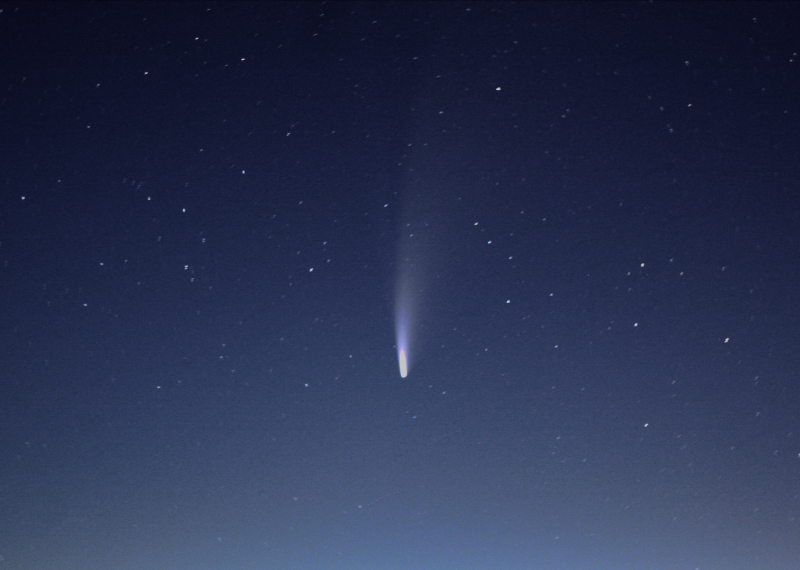 |
July 23, 2018, Thézac, Charente Maritime (dept. 17)
The ImagingSource camera is not working with my new laptop, impossible to take planetary images. So I shoot the deep sky, and I test color filters in binning 1x1. I shoot the planetary nebulae NGC7048 in Cygnus, the cocoon nebulae IC5156, then the classical M31, the Andromedae galaxy. The H-alpha shots failed.
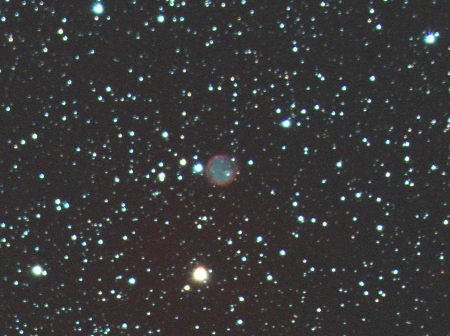 |
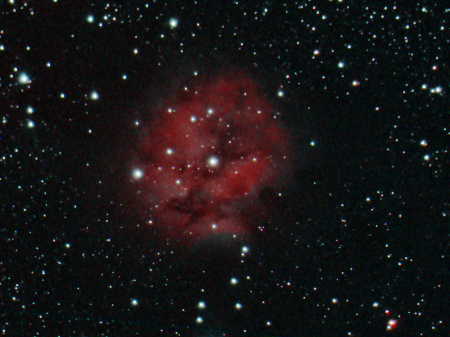 |
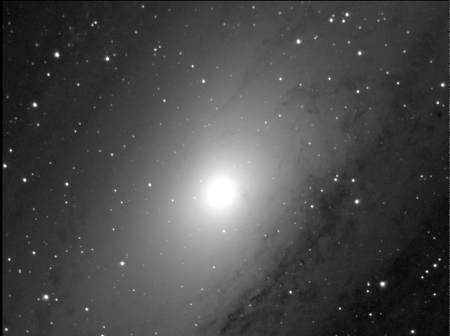 |
July 17, 2018, Thézac, Charente Maritime (17)
I take 30s pictures insteads of 120s, in fact it works fine as well. The off-axis guider is focused, much more fast and easy to install and efficient than the guiding scope. Tip for focusing the off-axis guider : watch Deneb star in the Milky Way, because there are many stars around. The probability to find a star in the guiding camera is high, so that focusing is possible.
 |
August 20 2017, Thézac, Charente Maritime (France, dept. 17)
Since I've changed my computer, the Atik 314L+ CCD camera isn't working anymore, I couldn't install the driver. Therefore I only use the Canon 450D camera, and guide with the C8. I shoot the Andromeda galaxy, which can be seen with naked eye as the condition is very good.
 |
August 24 2016, Thézac, Charente Maritime (France, dept. 17)
Conditions were good before the moonrise at about 1am. I shoot M27 and raw images are good, this object is easy because it is bright. When the moon rose I targeted the globular clusters M15 and M13, bright enough, then the moon.
 |
 |
 |
 |
 |
 |
August 23 2016, Thézac, Charente Maritime (France, dept. 17)
Now that I can use the off-axis guider, I try NGC6751, a small nebula which I never did, but I do only few exposures because it is too small. Then NGC7662 the Blue Snowball which I wanted to redo, then NGC7635 the Bubble nebula. I can't use the focal reducer because I can't reach the focal point, so I keep 2000mm focal length of the C8 telescope. I will need a new shorter T ring. Then I do the moon.
 |
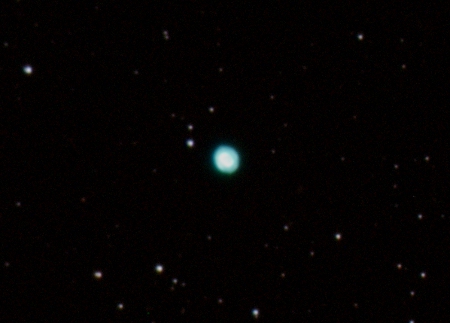 |
 |
August 22 2016, Thézac, Charente Maritime (France, dept. 17)
I finally could use the off-axis guider. I took me more than one hour to find the way to have light in the LodeStar, by adjusting the small screws and the small mirror. Then I focused the Atik, then the LodeStar. I also used PHD2 Guiding software for the first time.
 |
August 15, 2016, Thézac, Charente Maritime (France, dept. 17)
The moon is full so I try to shoot it, then I try the Wizard nebula with H-alpha filter which is not disturbed by the moonlight.
 |
 |
August 14, 2016, Thézac, Charente Maritime (France, dept. 17)
Guiding was quite good but the result has not enough details. I need more exposures, adn the moon was annoying.
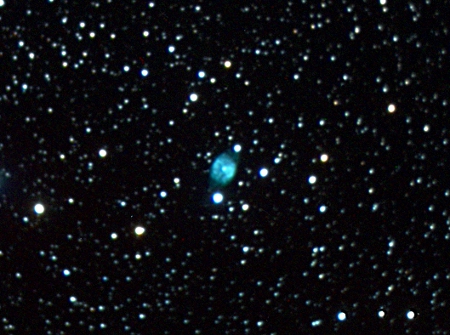 |
2015, september 28, Clamart, Hauts-de-Seine (France)
Very good conditions, picture taken at 4:22am. Next eclipse is in 2033, It's good I woke up this night!
 |
2015, july 15, Thézac, Charente Maritime (France)
Very good conditions, at last a good set up and a good auto-guiding. Everything went well, I even didn't use an ocular to initialize the "goto" function, I did it directly with the Atik camera. I think it was my best initial set up, few derivative, and the "goto" was very precise. The only small problem was that M63 was quite low in the sky, so the sky background was not as good as if the object was at the top of the sky, more difficult to process images, and some pictures of the end of the session could not be used. So I finished with M57 at 3:30am. Even with few pictures taken, the result is quite good because the mount followed well and M57 was at the top. I went to sleep at 5am.
 |
 |
2015, july 14, Thézac, Charente Maritime (France)
Good conditions, but I had lots of problems with the USB ports of the computer. The transfers of images from the Atik to the laptop were blocked, the LodeStar camera was bugging too so I had a lot of difficulties to set up the guiding. Finally I succeded, quite late, to launch 4 minutes exposures for M63, which is quite good. But I lost a lot of time and I didn't have the courage to do the color exposures. In the end we can see quite many details in this galaxy.
 |
July 9 2015, Thézac, Charente Maritime (dept. 17, France)
Deneb star, then the Andromeda galaxy M31 with the reflex camera Canon 450D, mounted in parralel of the 80ED refractor. The refractor was used for guiding. Good conditions, good guiding, but I was expecting a better result for the exposure time. The reflex camera is less efficient than the refractor or the telescope, but it allowed me to do the initial set up quickly. I used the EOS utility software, which allows to drive the camera and to take pictures automatically. Flat field images were difficult to do, because the range 19500 ADU did not seem reachable on the histogram, strange. I got a lower value, with 1/40s exposure, but the result seems correct in the end. End at 3am.
 |
 |
Flat field histogram : |
July 31 2014, Thézac, Charente Maritime (dept. 17, France)
I do M57 again with the C8 telescope. The problem is that it changes side of the mount during the night. The guiding is average. Then I do the Bubble nebula, the guiding is better.
 |
 |
July 29 2014, Thézac, Charente Maritime (dept. 17, France)
The ring planetary nebula. Problem with some passing clouds. Moreover the guiding was bad, surely due to a bad initial setup of the mount. I tried the off-axis guider, without success. Impossible to focus the guider. Then I tried to focus with each filter, but it is very difficult with the red one for example, stars are less shiny. Because of bad guiding, I had to do exposures of less time, 60s each.
 |
Jumy 25 2014, Thézac, Charente Maritime (dept. 17, France)
The Bode galaxy M81, then tries on M31 and M27, with the Orion short tube refractor, guiding with the 80ED refractor. Imaging with the Canon 450D camera. This is a new configuration which I wanted to test, the result is disapointing. I realize that the short tube is of bad quality on the edges of the image, it is better to use the 80ED refractor for imaging. The Canon camera is less sensitive than the Atik. For M31, it is too low in the sky, because the light of Saintes city disturbs the light on the East horizon.
 |
 |
July 24 2014, Thézac, Charente Maritime (dept. 17, France)
The galaxy NGC891 with 80ED refractor, guiding with C8 telescope. Then M31 because it is the easiest target, then quickly the pleiades for the end. NGC891 was quite low in the sky, with a fuzzy light at the East horizon due to Sainte city, but the picture could be done anyway.
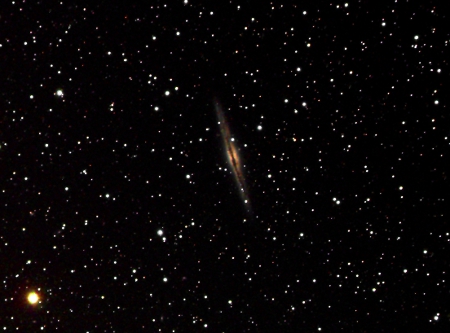 |
 |
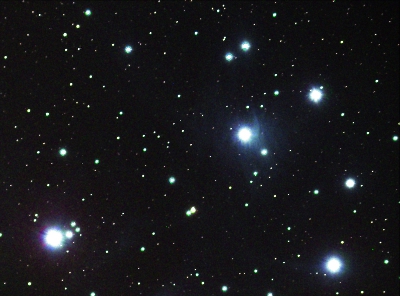 |
August 12 2013, Thézac, Charente Maritime (dept. 17, France)
The andromeda galaxy with the reflex camera. Quick test because clouds were coming. Only 2 exposures of 2 and 5 minutes. Zoom 250mm, in parralel of the 80ED refractor. No flat field done (can be noticed) nor dark and offset.
August 11 2013, Thézac, Charente Maritime (dept. 17, France)
The ring nebula M57, and the fireworks galaxy NGC6946. Problem with focusing on M57. I realized that the focus was disturbed by the C8 . I will need to check it more often in the future. The shoot in H-alpha did not work, raw images are bad.
 |
 |
August 10 2013, Thézac, Charente Maritime (dept. 17, France)
The galaxy NGC7331.
 |
August 1st 2013, Thézac, Charente Maritime (dept. 17, France)
NGC6951. I'm not happy with the result, the magnitude 11 of this object is too low I think.
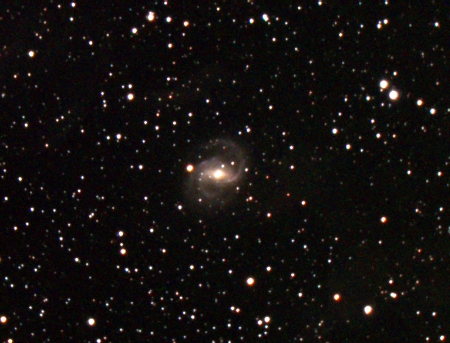 |
July 30 2013, Thézac, Charente Maritime (dept. 17, France)
M51 and NGC6951. It is not the best season for M51, but as I didn't prepare the night, I do the easiest. The night is beautiful, but humid, I get cold and become ill the following day. It's difficult to start again the ryhtm of astronomy, with a go to sleep at 3:30am.
 |
 |
August 22 2012, Thézac, Charente Maritime (dept. 17, France)
Try on M31, the Adromeda galaxy, then NGC6960, the Viel nebula. NGC6960 is always difficult to process.
 |
 |
August 21 2012, Thézac, Charente Maritime (dept. 17, France)
To try it, I target M57 with F=4000mm (barlow x2) with the C8 telescope, guiding with the 80ED refractor at F=1800mm (barlow x3). I do binning 2 and 3, beacsue with long focal length, I read it is not useful to do binning 1.
The result is not so bad I think!
Then I do the bubble nebula at F=600mm with the refractor, well placed in the sky. Guiding with C8 telescope at F=4m!
With the same configuration, I try M33, the Triangle galaxy.
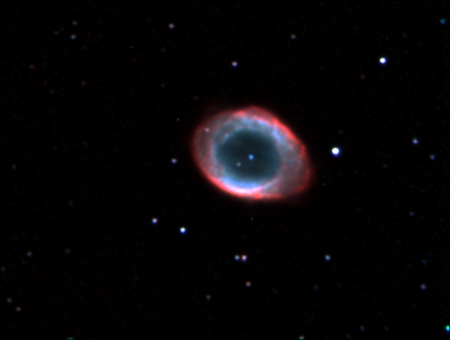 |
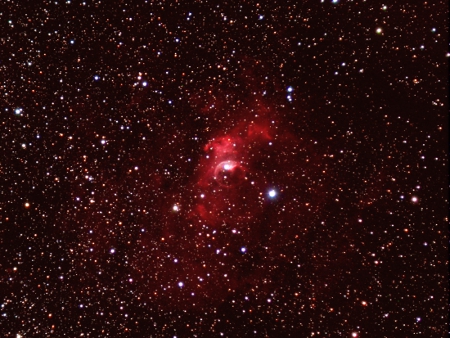 |
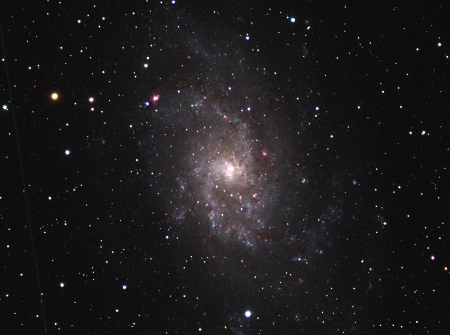 |
August 18 2012, Thézac, Charente Maritime (dept. 17, France)
The clouds seem to come, and I am tired, so I just do easy exposures withe the Canon 450D. I do M31, the Hercule cluster, and M57, the ring nebula, which are easy targets with high magnitude.
 |
 |
August 17 2012, Thézac, Charente Maritime (dept. 17, France)
Again a beautiful night, I do NGC891, which I would like to improve, then NGC772 a galaxy that I have never shot, then ARP188, the Tadpole galaxy. This allows me to test the GoTo function by entering the coordinates because this object is not know by the hand controller.
I still use the C8 with F/6.3, the Atik 314L+ CCD camera, and the 80ED refractor at F=1200mm and the LodeStar for guiding.
The Tadpole galaxy is not very shiny, I will need to redo it later.
 |
 |
 |
August 16 2012, Thézac, Charente Maritime (dept. 17, France)
Perfect night, without moon. I shoot NGC7479, the "Superman" galaxy whose name come from its S shape, and M74 in Andromeda constellation and Perseu, with the Atik 314L+.< Nuit parfaite, sans lune. J'image NGC7479, la galaxie "Superman" nommée ainsi à cause de sa forme en S, et M74 dans Andromède et Persée, avec l'Atik 314L+.
Configuration : C8 at F/6.3 with Atik 314L+, and 80ED refractor at F=1200mm and the LodeStar for guiding.
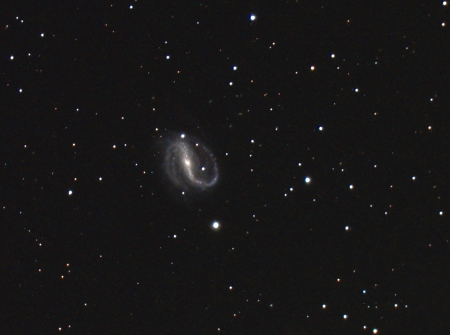 |
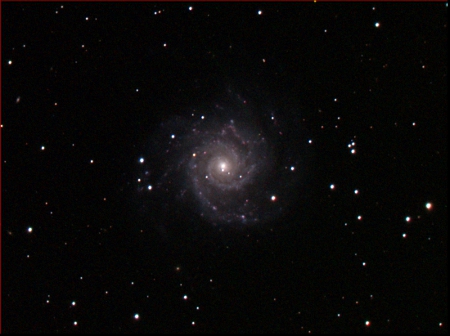 |